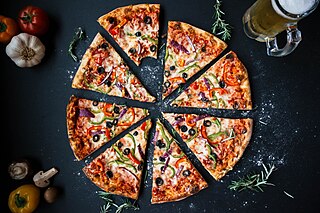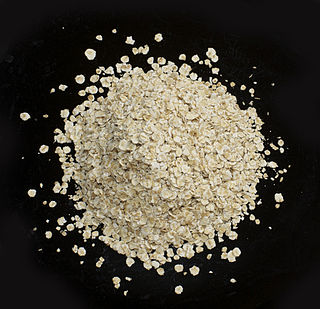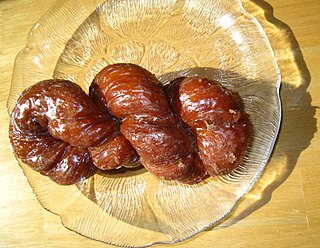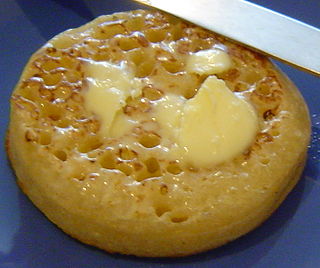This article needs additional citations for verification .(August 2015) |
Throdkin is a traditional breakfast food of the Fylde, Lancashire, England. There are different preparations but all are made from oatmeal and bacon fat. [1]
This article needs additional citations for verification .(August 2015) |
Throdkin is a traditional breakfast food of the Fylde, Lancashire, England. There are different preparations but all are made from oatmeal and bacon fat. [1]
One recipe calls for a pound of oatmeal mixed with some bacon fat to create a dough the consistency of pastry. The dough is then shaped into a brick shape and baked, often with a strip of bacon on top. [1] Another version consists of a dough of oatmeal and water pressed into a pie plate, topped with pieces of fat bacon, and baked. It was cut into wedges tart-style for serving[ citation needed ]
The throdkin could also be baked and then fried in bacon fat. [1]
There is a sweet variety from Blackpool which incorporates currants. [1]
It is listed, with an earliest instance in 1837, by Joseph Wright in his 1905 The English Dialect Dictionary. [2]

A cookie or biscuit is a baked snack or dessert that is typically small, flat, and sweet. It usually contains flour, sugar, egg, and some type of oil, fat, or butter. It may include other ingredients such as raisins, oats, chocolate chips, or nuts.

Pizza is a dish of Italian origin consisting of a usually round, flat base of leavened wheat-based dough topped with tomatoes, cheese, and often various other ingredients, which is then baked at a high temperature, traditionally in a wood-fired oven.

Pastry is baked food made with a dough of flour, water, and shortening that may be savoury or sweetened. Sweetened pastries are often described as bakers' confectionery. The word "pastries" suggests many kinds of baked products made from ingredients such as flour, sugar, milk, butter, shortening, baking powder, and eggs. Small tarts and other sweet baked products are called pastries as a synecdoche. Common pastry dishes include pies, tarts, quiches, croissants, and pasties.

A croissant is a French pastry made from puff pastry in a crescent shape.

Oatmeal is a preparation of oats that have been de-husked, steamed, and flattened, or a coarse flour of hulled oat grains (groats) that have either been milled (ground), rolled, or steel-cut. Ground oats are also called white oats. Steel-cut oats are known as coarse oatmeal, Irish oatmeal, or pinhead oats. Rolled oats were traditionally thick old-fashioned oats, but can be made thinner or smaller, and may be categorized as quick oatmeal or instant oatmeal depending on the cooking time required, which is determined by the size of the oats and the amount of precooking.

A bagel is a bread roll originating in the Jewish communities of Poland. Bagels are traditionally made from yeasted wheat dough that is shaped by hand into a torus or ring, briefly boiled in water, and then baked. The result is a dense, chewy, doughy interior with a browned and sometimes crisp exterior.

A scone is a traditional British baked good, popular in the United Kingdom and Ireland. It is usually made of either wheat flour or oatmeal, with baking powder as a leavening agent, and baked on sheet pans. A scone is often slightly sweetened and occasionally glazed with egg wash. The scone is a basic component of the cream tea. It differs from teacakes and other types of sweets that are made with yeast. Scones were chosen as the Republic of Ireland representative for Café Europe during the Austrian presidency of the European Union in 2006, while the United Kingdom chose shortbread.

Pierogi or Pierogies are filled dumplings, made by wrapping unleavened dough around a filling, and occasionally flavored with a savory or sweet garnish and cooked in boiling water.

A cruller is a deep-fried pastry popular in parts of Europe and North America. Regarded as a form of cake doughnut in the latter, it is typically either made of a string of dough that is folded over and twisted twice to create its signature shape, or formed from a rectangle of dough with a cut in the center allowing it to be pulled over and through itself to produce distinctive twists in the sides of the pastry.

A crumpet is a small griddle bread made from an unsweetened batter of water or milk, flour, and yeast, popular in the United Kingdom, Canada, New Zealand, South Africa and Australia.

Boxty is a traditional Irish potato pancake. The dish is mostly associated with the north midlands, north Connacht and southern Ulster, in particular the counties of Leitrim, Mayo, Sligo, Fermanagh, Longford, and Cavan. There are many recipes but all contain finely grated, raw potatoes and all are served fried.

A bear claw is a sweet, yeast-raised pastry, a type of Danish, originating in the United States during the mid-1910s. In Denmark, a bear claw is referred to as a kam. France also has an alternate version of that pastry: patte d'ours, created in 1982 in the Alps. The name bear claw as used for a pastry is first attested in March 1914 by the Geibel German Bakery, located at 915 K Street in downtown Sacramento. The phrase is more common in Western American English, and is included in the U.S. Regional Dialect Survey Results, Question #87, "Do you use the term 'bear claw' for a kind of pastry?"

A bannock is a variety of flatbread or quick bread cooked from flour, typically round, which is common in Scotland and other areas in the British Isles. They are usually cut into sections before serving.

Parkin is a gingerbread cake traditionally made with oatmeal and black treacle, which originated in Northern England. Often associated with Yorkshire, it is widespread and popular elsewhere, notably in Lancashire. Parkin is baked to a hard cake but with resting becomes moist and even sometimes sticky. There are regional differences, for example in Hull and East Yorkshire, it has a drier, more biscuit-like texture than in other areas whereas in Lancashire it is generally made with golden syrup rather than the treacle used elsewhere. Parkin is traditionally eaten on Guy Fawkes Night, 5 November, and when celebrating 'Yorkshire Day' on 1 August. But is also enjoyed throughout the winter months. It is baked commercially throughout Yorkshire, but is mainly a domestic product in other areas.

Johnnycake, also known as journey cake, johnny bread, hoecake, shawnee cake or spider cornbread, is a cornmeal flatbread, a type of batter bread. An early American staple food, it is prepared on the Atlantic coast from Newfoundland to Jamaica. The food originates from the indigenous people of North America. It is still eaten in the Bahamas, Belize, Bermuda, Canada, Colombia, Curaçao, Dominican Republic, Jamaica, Puerto Rico, Saint Croix, and the United States.

The Bedfordshire clanger is a dish from Bedfordshire and adjacent counties in England, such as Buckinghamshire and Hertfordshire. It dates back to at least the 19th century. It is still available at various bakers and served at some cafes, restaurants and local places of interest.

The Lancashire dialect refers to the Northern English vernacular speech of the English county of Lancashire. The region is notable for its tradition of poetry written in the dialect.

A singing hinny or singin' hinny is a type of bannock, griddle cake or scone, made in the north of England, especially Northumberland and the coal-mining areas of the North East. In Scotland, they are known as fatty cutties.

Black pudding is a distinct regional type of blood sausage originating in the United Kingdom and Ireland. It is made from pork or occasionally beef blood, with pork fat or beef suet, and a cereal, usually oatmeal, oat groats, or barley groats. The high proportion of cereal, along with the use of certain herbs such as pennyroyal, serves to distinguish black pudding from blood sausages eaten in other parts of the world.